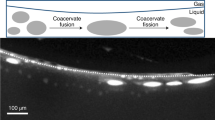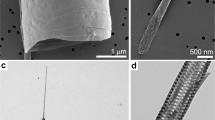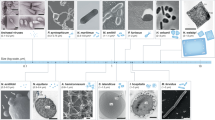Abstract
The first cellular systems to appear on the Earth were presumably assembled from three molecular species: information-storing molecules capable of replication, enzyme-like catalysts structurally encoded by that information and able to enhance replication rates, and boundary-forming molecules which could encapsulate the system represented by the first two molecular species. Encapsulation would provide a microenvironment conducive to interaction of the molecular species involved, and would further serve to differentiate such systems according to their reproductive success. Boundary structures could also provide permeability properties useful for the directed transport of nutrient molecules required for growth and replication. The experiments reported here focused on non-polar molecules extracted from carbonaceous chrondrites. Such molecules represent plausible models for the mixture of organic substances present on the early Earth. We found that certain components in the extract have physical properties which lead to the formation of boundary structures.
This is a preview of subscription content, access via your institution
Access options
Subscribe to this journal
Receive 51 print issues and online access
$199.00 per year
only $3.90 per issue
Buy this article
- Purchase on Springer Link
- Instant access to full article PDF
Prices may be subject to local taxes which are calculated during checkout
Similar content being viewed by others
References
Eigen, M. Adv. Chem. Phys. 38, 211–261 (1977).
Inoue, T. & Orgel, L. E. Science 219, 859–862 (1983).
White, D. J. molec. Evol. 16, 121–147 (1980).
Kuhn, H. Angew. Chem. int. Edn. Engl. 11, 798–820 (1972).
Hargreaves, W. R., Mulvihill, S. J. & Deamer, D. W. Nature 266, 78–80 (1977).
Epps, D. E., Sherwood, E., Eichberg, H. & Oro, J. J. molec. Evol. 11, 279–292 (1978).
Rao, M., Eichberg, J., Oro, J. J. molec. Evol. 18, 196–202 (1982).
Gebicki, J. M. & Hicks, M. Nature 243, 232–234 (1973).
Hargreaves, W. R. & Deamer, D. W. Biochemistry 17, 3759–3768 (1978).
Hayatsu, R. & Anders, E. Curr. Topics Chem. 99, 1–37 (1981).
Bunch, T. E. & Chang, S. Geochim. cosmochim. Acta 44, 1543–1577 (1980).
Yuen, G., Blair, N., Des Marais, D. J. & Chang, S. Nature 307, 252–254 (1984).
Alpern, B. & Benkheiri, Y. Earth planet. Sci. Lett. 19, 422–428 (1973).
Anders, I., Hayatsu, R. & Studier, M. H. Science 182, 781–788 (1973).
Lawless, J. & Yuen, G. Nature 282, 396–398 (1979).
Adam, N. K. The Physics and Chemistry of Surfaces, 47 (Dover, New York, 1968).
Oparin, A. I. & Gladilin, K. L. BioSystems 12, 133–145 (1980).
Pflug, D. H. Naturwissenschaften 71, 531–533 (1984).
Author information
Authors and Affiliations
Rights and permissions
About this article
Cite this article
Deamer, D. Boundary structures are formed by organic components of the Murchison carbonaceous chondrite. Nature 317, 792–794 (1985). https://doi.org/10.1038/317792a0
Received:
Accepted:
Published:
Issue Date:
DOI: https://doi.org/10.1038/317792a0
This article is cited by
-
Formation of vesicular structures from fatty acids formed under simulated volcanic hydrothermal conditions
Scientific Reports (2023)
-
Self-reproducing catalytic micelles as nanoscopic protocell precursors
Nature Reviews Chemistry (2021)
-
Plausible Emergence and Self Assembly of a Primitive Phospholipid from Reduced Phosphorus on the Primordial Earth
Origins of Life and Evolution of Biospheres (2021)
-
Dynamics of the vesicles composed of fatty acids and other amphiphile mixtures: unveiling the role of fatty acids as a model protocell membrane
Biophysical Reviews (2020)
-
Organometallic compounds as carriers of extraterrestrial cyanide in primitive meteorites
Nature Communications (2019)
Comments
By submitting a comment you agree to abide by our Terms and Community Guidelines. If you find something abusive or that does not comply with our terms or guidelines please flag it as inappropriate.



